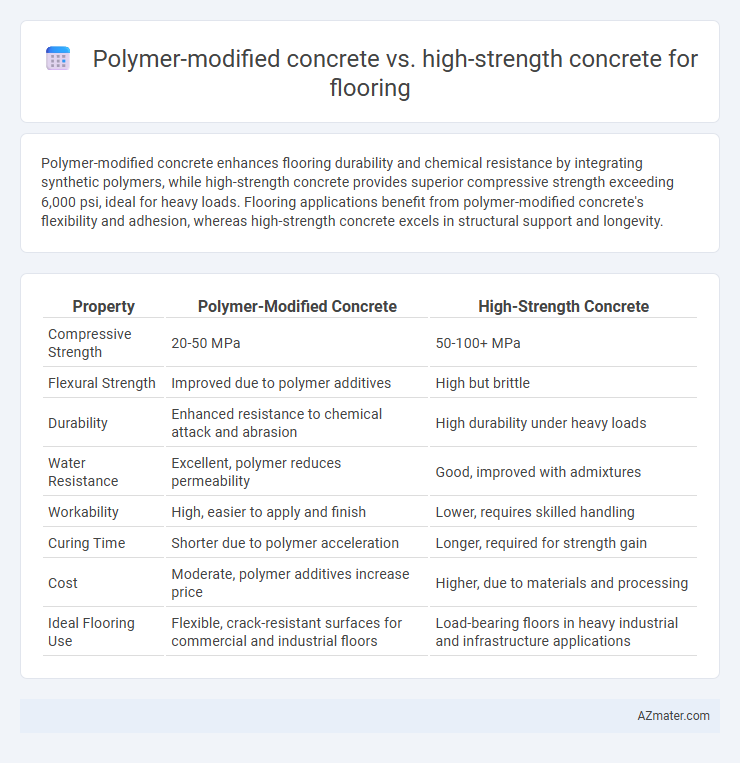Polymer-modified concrete enhances flooring durability and chemical resistance by integrating synthetic polymers, while high-strength concrete provides superior compressive strength exceeding 6,000 psi, ideal for heavy loads. Flooring applications benefit from polymer-modified concrete's flexibility and adhesion, whereas high-strength concrete excels in structural support and longevity.
Table of Comparison
| Property | Polymer-Modified Concrete | High-Strength Concrete |
|---|---|---|
| Compressive Strength | 20-50 MPa | 50-100+ MPa |
| Flexural Strength | Improved due to polymer additives | High but brittle |
| Durability | Enhanced resistance to chemical attack and abrasion | High durability under heavy loads |
| Water Resistance | Excellent, polymer reduces permeability | Good, improved with admixtures |
| Workability | High, easier to apply and finish | Lower, requires skilled handling |
| Curing Time | Shorter due to polymer acceleration | Longer, required for strength gain |
| Cost | Moderate, polymer additives increase price | Higher, due to materials and processing |
| Ideal Flooring Use | Flexible, crack-resistant surfaces for commercial and industrial floors | Load-bearing floors in heavy industrial and infrastructure applications |
Introduction: Understanding Flooring Requirements
Polymer-modified concrete enhances flooring durability by incorporating additives that improve adhesion, flexibility, and resistance to chemicals and abrasion, making it ideal for areas with heavy mechanical stress. High-strength concrete offers superior compressive strength and load-bearing capacity, suitable for floors subjected to intense static loads and structural demands. Selecting the appropriate material depends on specific flooring requirements such as load conditions, exposure to chemicals, and wear resistance to ensure long-term performance.
Overview of Polymer-Modified Concrete
Polymer-modified concrete incorporates polymers to improve adhesion, flexibility, and chemical resistance, making it ideal for flooring exposed to heavy wear and moisture. This type of concrete enhances tensile strength and reduces permeability, which prevents cracking and extends the longevity of floor surfaces in industrial and commercial settings. Compared to traditional high-strength concrete, polymer modification offers superior durability in environments where impact and chemical exposure are critical concerns.
Key Features of High-Strength Concrete
High-strength concrete features a compressive strength typically above 6,000 psi, offering superior load-bearing capacity and durability for flooring applications. Its dense microstructure reduces permeability, enhancing resistance to abrasion, chemical attack, and freeze-thaw cycles, which is critical for industrial and commercial floors. The material's lower water-cement ratio and use of supplementary cementitious materials contribute to long-term performance and dimensional stability in high-traffic environments.
Comparative Strength Characteristics
Polymer-modified concrete enhances tensile strength and flexibility by incorporating polymers, making it ideal for flooring subjected to dynamic loads and crack resistance. High-strength concrete offers superior compressive strength, typically exceeding 6000 psi, providing excellent durability for heavy-load bearing floors. While polymer-modified concrete excels in impact resistance and bonding, high-strength concrete is preferred for structural floors requiring maximum load capacity.
Durability and Longevity Considerations
Polymer-modified concrete enhances durability by improving resistance to chemicals, abrasion, and impact, making it ideal for flooring in industrial and high-traffic environments. High-strength concrete offers superior compressive strength and load-bearing capacity, providing longevity in structurally demanding applications. Choosing between polymer-modified and high-strength concrete depends on specific flooring requirements such as chemical exposure, mechanical stress, and anticipated service life.
Application Performance in Flooring
Polymer-modified concrete enhances flooring performance by improving adhesion, flexibility, and resistance to chemicals and abrasion, making it ideal for industrial and commercial floors subject to heavy traffic and harsh conditions. High-strength concrete offers superior compressive strength and durability, suitable for flooring systems requiring load-bearing capacity and structural integrity under dynamic loads. Both materials optimize flooring longevity, with polymer modifications focusing on surface resilience and high-strength concrete emphasizing structural support.
Surface Finish and Aesthetic Flexibility
Polymer-modified concrete enhances surface finish by providing superior adhesion, reduced permeability, and increased resistance to wear, making it ideal for achieving smooth and durable flooring. High-strength concrete offers exceptional compressive strength but may require additional treatments or coatings to improve surface aesthetics and finish quality. Polymer-modified formulations allow greater aesthetic flexibility through enhanced compatibility with stains, pigments, and decorative overlays compared to the typically more rigid finish of high-strength concrete.
Cost Implications and Economic Analysis
Polymer-modified concrete (PMC) generally incurs higher initial costs due to expensive additives that enhance adhesion and durability, making it suitable for specialized flooring applications requiring chemical resistance and flexibility. High-strength concrete (HSC), while less costly upfront, offers superior compressive strength and longevity, reducing maintenance expenses and lifecycle costs in heavy-load flooring scenarios. Economic analysis often favors HSC for large-scale projects due to its cost-efficiency and structural benefits, whereas PMC is preferred for targeted performance improvements despite higher material costs.
Installation Methods and Practical Challenges
Polymer-modified concrete requires surface preparation including primer application to enhance adhesion and flexibility during flooring installation, while high-strength concrete demands precise water-cement ratio control and curing conditions to achieve optimal strength and durability. Installation of polymer-modified concrete can be faster due to improved workability and reduced shrinkage, yet it may present challenges such as sensitivity to temperature variations affecting polymer properties. High-strength concrete poses practical challenges like increased brittleness and potential cracking, necessitating careful handling and use of specialized equipment to ensure proper placement and finish.
Choosing the Right Concrete for Flooring Needs
Polymer-modified concrete enhances adhesion, flexibility, and chemical resistance, making it ideal for industrial flooring exposed to heavy wear and chemical spills. High-strength concrete offers superior compressive strength and durability, suitable for heavy load-bearing floors in commercial or infrastructural projects. Selecting the right concrete depends on specific flooring demands such as load intensity, exposure conditions, and longevity requirements.

Infographic: Polymer-modified concrete vs High-strength concrete for Flooring
 azmater.com
azmater.com